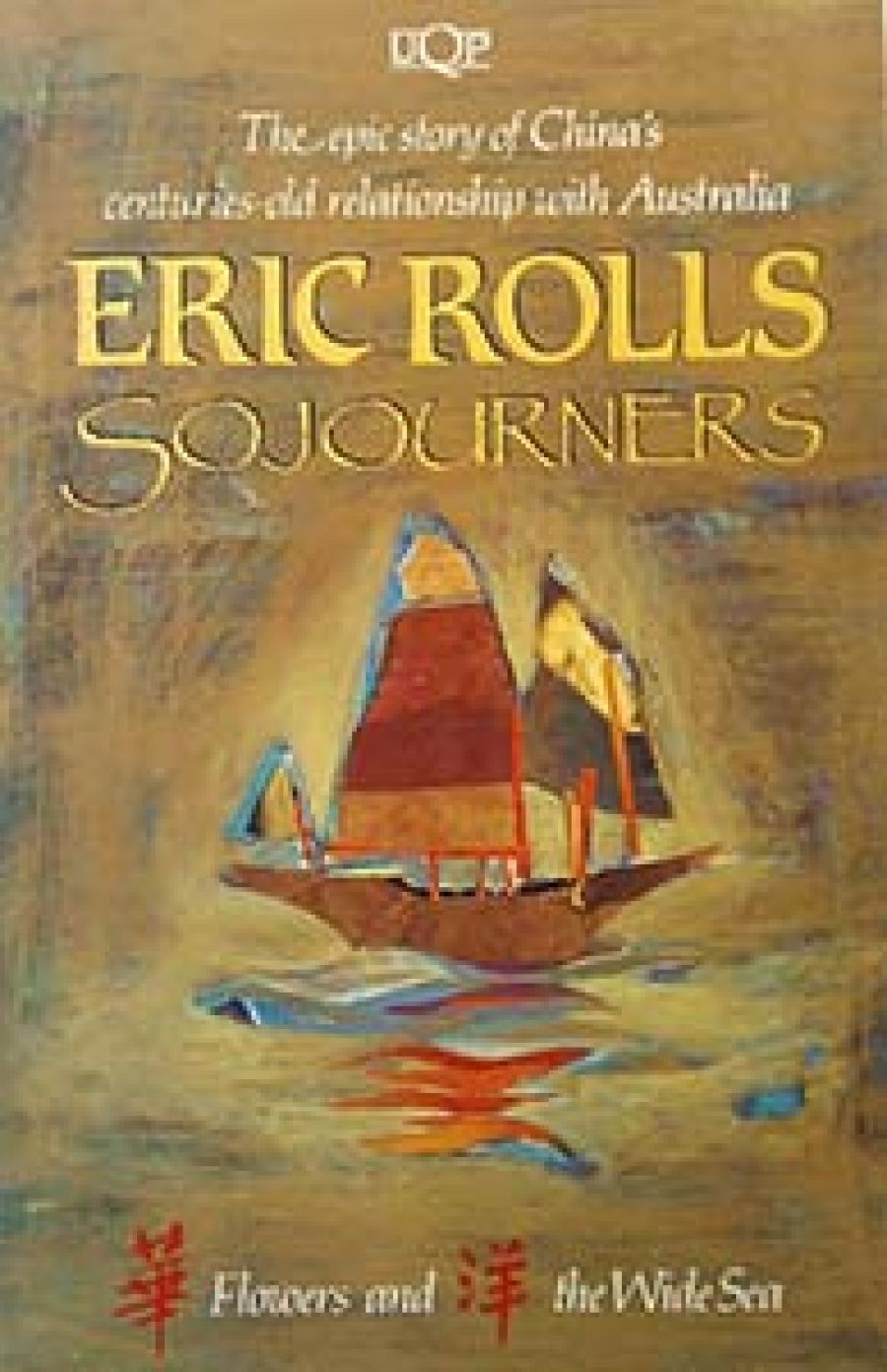
- Free Article: No
- Contents Category: Australian History
- Review Article: Yes
- Online Only: No
- Custom Highlight Text:
Mr Rolls has written an extraordinarily detailed history of the Chinese in Australia, interspersed with much additional related and unrelated matter. It is indeed a labour of love, written over a period of some twenty years, and the author has uncovered a large amount of fascinating and amazing information not readily available elsewhere. Much of this new material relates to the vibrant popular culture the Chinese brought with them: their food, cricket fighting, cock fighting, and other sorts of fairly harmless gambling; their diseases, living conditions and relations with their non-Chinese neighbours. A certain amount of the book concerns immigration acts and other forms of discrimination, of course, but the stronger impression one gets is a more positive one: the Chinese as hard workers and major contributors to Australian life.
- Book 1 Title: Sojourners
- Book 1 Subtitle: The epic story of China’s centuries-old relationship with Australia
- Book 1 Biblio: University of Queensland Press, $49.95 hb
Some of the information in this book is new and important as an aspect of Chinese social history in Australia. The Rules of the Kong Chew Society, dated 1854, if they are genuine, represent a very sophisticated attitude in regard to the problems of Chinese living in a foreign country. The story about a Singapore-born Chinese who bought a carriage and horses and went for a drive on the Shanghai racecourse in 1858, or the use of beggar boys to produce smallpox vaccination for wealthy families hardly seems credible. The lack of references makes it very difficult to check such information. Mr Rolls is a writer, not a historian, and has not questioned such stories. The text is full of giveaway lines, such as, ‘Professor C.P. Fitzgerald, the brilliant, innovative and practical historian who made the first serious European studies of China’. They lead one to suspect some of the other statements and judgements in this book may not necessarily be reliable. Thus, while it is certainly ‘a good read’, it cannot be relied on for accuracy. Considering the enormous amount of work that has gone into it, the mass of detail and the polished style, this is a great pity.
Mr Rolls has gone to a great deal of trouble to provide Chinese characters for many of the Chinese words and expressions in the text, a rarity in a work of this kind, and to be greatly commended. Almost all of them are correct. Elegant calligraphy (I don’t think the name of the calligrapher is given) graces the headings to each chapter. Very often he explains various Chinese terms, but some of these are far-fetched, perhaps based on folk etymologies. Such information is ‘quaint’ for the general reader and could be of use to the researcher, but has to be used with great caution.
The wealth of detail is one of the most obvious, and attractive, aspects of this book. Mr Rolls gives us the price of gold per ounce at various times, the price of tin, exchange rates, wages, dates, and names in abundance. This leads to a most unfortunate fault with this book, in my view: the absolute lack of references. The author notes in his preface that he has not annotated the work because it would take another year, and he wanted to get on with other writing. But the fact remains that the main people interested in the mass of detailed information in this book will not be general readers but students and researchers of one type or another, who have no way of checking on the information in Mr Rolls’s book, short of re-reading all the original source material themselves. As (non-specific) references in the bibliography are given as ‘Sydney Morning Herald, 1851–1893 and 1969–1988’, that is a tall order. What could have been an invaluable source-book for the history of the Chinese in Australia is, alas, from that point of view, practically useless. (Not completely useless; the Bibliography will at least contribute to a basic ‘library search’ for the budding researcher.)
The other major shortcoming of this book is that it is dreadfully overwritten. Much of it has to do with broader issues of Australian history or social history; one can sometimes read for twenty or thirty pages without seeing a mention of a Chinese at all. Too much of the book, particularly in the later chapters, is concerned with detailed descriptions of gambling dens in modern Macao, yum-cha restaurants in Sydney and Hong Kong, records of Mr Rolls’s travels, meals, and experiences in such establishments, opium production in Burma in the 1980s, triads in modern Hong Kong, various aspects of life in contemporary China, and assorted musings on the meaning of life, practically none of which is relevant to the matter in hand. Almost all the photographs in the book concern China in the 1980s, and seem out of place in a book ostensibly about Chinese in Australia a century ago. The cartoons date from the right period; it should have been possible to find photographs. (The Museum of Australian Chinese History in Melbourne has a large collection.)
All in all, it is a good thing that this book has been written. It is a sympathetic and essentially human approach to the many individual Chinese who spent at least a part of their lives in Australia, and to their descendants and more recent arrivals. Mr Rolls has recorded the names, details, and activities of many otherwise unknown and unremembered pioneers in Australia, and has done so in a way that makes it easy to relate to them, feel with them, and accept them. The Chinese press in Australia has carried very laudatory reviews of this book, and it will certainly contribute to the growing acceptance of the Chinese community as an inalienable part of Australian history and contemporary Australian society.


Comments powered by CComment